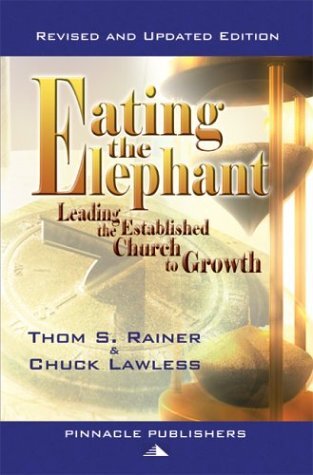Thom Rainer and Charles Lawless, Eating the Elephant: Leading the Established Church to Growth, Revised and Updated. Pinnacle Publications, 2003.
- Church Leadership Strategies – People-Directed Vision Emergence
- Church Leadership Strategies – Traditional Church Renewal
LifeandLeadership.com Summary
Many books on church renewal assume an unrealistic level of intentionality that does not exist in long-established churches. Many also presume a CEO-type of clout or professional credibility in the minister that certainly is not characteristic of most traditional churches. Not uncommonly, established churches are highly suspect of strong visionary leadership from one person. There are situations where a dynamic leader facilitates turnaround growth in older congregations blessed by their ministries, and they are the stuff of legends. It is easy for a church leader who desires renewal to start copying their approaches. This usually leads to disappointment. Usually, established traditional churches have unique features that require special attention before one can realize renewal.
In my opinion, no one addresses the realities of vision-casting in established traditional churches like Thom Rainer and Chuck Lawless in Eating the Elephant. It is perhaps the most helpful and realistic model available.
The authors operate from a hopeful stance that traditional churches can become more effective, but only if leaders understand the special dynamics of these congregations. In chapter 1, they describe the differences between traditional and non-traditional churches, and the common pitfalls of the traditionals. Next they discuss the unique vision pathways these churches possess that are not found in more contemporary groups. These are balanced by common vision obstacles. This is followed by a personal assessment for the minister who is considering leading an established church down the vision path.
Chapter 2 is foundational to the rest of the book, presenting the “Vision Cycle of a Healthy Traditional Church.” (39) A church may be in a state of “organizational entrenchment” or mission ineffectiveness, but they can increase their productivity if they will activate the following cycle:
- Build momentum through an outward focus.
- Unleash the church by providing opportunities for members to discover and use their gifts.
- Give attention to the rekindled vision that results from steps 1 and 2.
- Capitalize on the renewed vision by introducing even more challenging measures toward ministry and growth.
- Provide lean organization and structure as needed.
In this way, vision is rekindled not by a top-down pastor-lead approach – God speaks to pastor; pastor informs and leads people – the process described in most vision-casting material. Instead, Rainer and Lawless suggest the vision is people-led: God, through the spiritual gifts and ministry callings of the people, leads them into ministry according to their giftedness and calling. The pastor discerns what God is doing as they follow their ministry passions, and equips the people as they continue to develop ministries according to the vision. Thus vision emerges, bubbles-up, or perhaps even “sneaks up” on a church. The minister’s role is to empower, discern, communicate, and equip.
In planning language, this is a more informal approach to church development. The minister does a lot of praying, listening, watching, “hanging around,” documenting, journaling, praying, motivating, encouraging, praising, praying, etc. It is no less intentional than most, but much more trust-building and natural.
In Part II, the authors give fuller development of each component of the vision cycle. They also include an excellent chapter of the role of prayer in the vision process. They present three actual cases of traditional church growth and extract then general lessons. Part III discusses four common obstacles to the vision process.
I cannot overstate the value of this book for ministers of established and/or traditional churches. It presents a very realistic and practical model. Also, while Rainer and Lawless are typically associated with the church growth movement, this model adapts nicely to more missional/emerging philosophies. Every minister of an established church should read this volume.
From the Publisher
How Does an Established Church Grow?
Many church leaders have attempted the “latest” approach to growing a church, only to find the methodology is ineffective and the church members are divided. Sometimes the methodology is wrong. Sometimes the methodology is right but the pace and the timing are wrong.
Internationally-recognized authorities Thom Rainer and Chuck Lawless have written Eating the Elephant to show that a church can change and grow if you move at a pace that fits the church’s situation, if you eat the elephant one bite at a time.
“Unfortunately,” the authors write, “many ‘traditional’ churches have been divided and demoralized by attempts to move the church too quickly toward relevancy. Is there a way to implement change without destroying the church in the process? We believe there is.” For most of America’s church leaders, that’s an invitation to tie on your napkin and pull up a chair.
About the Authors
Thom S. Rainer holds the Ph.D. from the Southern Baptist Theological Seminary, where he has served for over a decade as the founding dean of the Billy Graham School of Missions, Evangelism and Church Growth. The author of 15 books and hundreds of articles, Dr. Rainer also serves as president of the Rainer Group, one of the leading church and denominational consulting firms in the nation.
Chuck Lawless serves as the senior associate dean of the Billy Graham School of Missions, Evangelism and Church Growth. A Ph.D. graduate of Southern Seminary, Chuck also served as a senior pastor for fourteen years prior to joining the faculty at the Graham School. He is also the author of Spiritual Warfare: Biblical Truth for Victory, Discipled Warriors, Making Disciples through Mentoring, and Serving in Your Church Prayer Ministry.
***For additional information on this resource, including reviews, click the bookstore links. Check the reference at page top or the links below for resource guides on related topics.***
See Resources on Over 100 Areas of Ministry Leadership:


